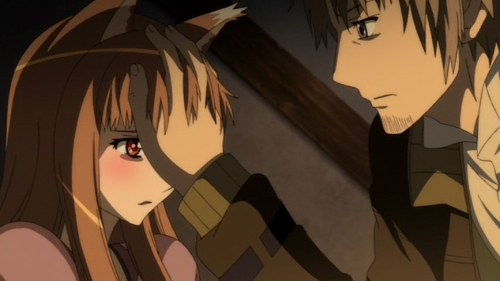Spice and Wolf

Overview
I think after 11 years of being universally loved, I can safely say that Spice and Wolf is a classic. However, I didn’t have high hopes for it when I began watching. I mean, it’s a series about a merchant teaching a wolf-girl basic economics, so how exciting could it really be?
As it turns out, all those people who loved this series over the past decade were onto something. Spice and Wolf isn’t really supposed to be an exciting anime, if anything it’s a cozy anime, and if I had watched it when it originally aired, I probably would have thought that meant it was boring.
Yes, there’s action at times, but I never felt that the action was all that important. What’s more important is the relationship between our main duo of Lawrence and Holo, and the suspense that’s generated due to the various situations they find themselves in.
The main draw to the series for a lot of people is probably the romance aspect between Lawrence and Holo. Over the course of the first season, which this post is exclusively about, the pair become near inseparable as they fill the void in each others’ hearts from years of living solo lives.
But, as I mentioned, there’s also a fair amount of suspense generated by the story even if there isn’t all that much actual action. Sometimes we’re left wondering how Lawrence is going to get out of some debt he’s incurred, and other times Holo is being chased down by the church for being a pagan deity.
Characters
This time around our protagonist’s name is Kraft Lawrence, and he’s a 25-year-old merchant. Honestly, when I learned that Lawrence was only supposed to be 25 I was shocked. I was sure he was supposed to at least be in his 30s if not 40s.
Lawrence is currently a member of a merchant’s guild and travels between various towns and cities with his wagon of goods. However, his true dream is to one day make enough money to open up his own store so he can settle down and truly begin his life.
Despite his apparent age, Lawrence is also highly skilled at his craft. He knows when to invest in certain goods, the differences in purity between all the coins from various cities, and they best ways to avoid being robbed; all skills a good merchant needs.

However, it’s Lawrence’s unlikely companion who really pushes his ability as a merchant over the edge. Holo is a wolf deity who once watched over a particular village and helped its crops flourish. However, with the invention of new, more robust seeds, the people no longer have a reason to worship her.
So, she decides to return to her homeland in the mountains to the far North, and chooses Lawrence as her travelling companion. While he sees her simply as another mouth to feed at first, it quickly becomes apparent that Holo possesses unique abilities that will aid him in his quest for wealth.
Not only can Holo determine if people are being truthful, something merchants have to worry about on a daily basis, but she’s also an extremely sly negotiator. She’s able to talk vendors into decreasing the prices of their goods, or even convince buyers that Lawrence’s goods are higher quality than they really are.
Also, Holo is basically just an older, more tsundere predecessor to Raphtalia from The Rising of the Shield Hero. Her design isn’t quite as nice, and she tends to act more mature, but other than that they’re the same character as far as I’m concerned.
The third and final character I’ll mention is Nora. Nora is a young girl who works as a shepherd for the local church. However, because she and her dog Enek are so good at protecting sheep from wolves, the church believes she must be some sort of witch.
Ah, yes, the good old days when being good at your job meant you were a witch. Because of this fear, the church constantly sends Nora to graze her flock in the most dangerous regions where other shepherds dare not go.
Their thought process is that if she comes back safe, she must be a witch, but if she dies, then she wasn’t a witch, but also isn’t their problem anymore. It’s a classic case of “damned if you do, damned if you don’t.”
Nora joins Lawrence and Hollow on their travels after she successfully leads them through dangerous territory multiple times safely. But, Holo isn’t exactly fond of Nora both because she’s a shepherd and because she thinks Lawrence will fall for her.
Conclusion
The first season of Spice and Wolf is a solid 8/10, which isn’t something I really expected from the studio Imagin. I’ve seen one anime they’ve produced, Alderamin on the Sky, and that was bad, so I wouldn’t have expected a series animated by them to be much better.
The second season is animated by two different studios I’ve never heard of before, so it’ll be interesting to see what differences there are between that season and this first one. Stay tuned for a review of season two in the eventual future.
If you enjoyed this review then be sure to click the like button ❤ down below. Also, give me a follow over on Twitter @DoubleSama so you don’t miss out on any future content. I tweet out every time a new post goes live, so it’s the best way to stay up to date.
Finally, I’d like to thank HeavyROMAN for supporting DoubleSama.com at the Heika tier this month, as well as Rob Wright and Keyboard Kadabra for their support at the Kouhai tier. To learn more about how you can become a supporter of this blog, check out Patreon.com/DoubleSama.
My review of Spice and Wolf II is available now.







